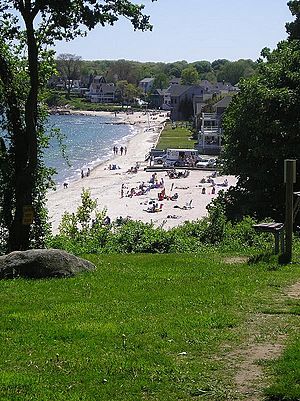McCook Park Beach facts for kids
Quick facts for kids McCook Point Park |
|
|---|---|
| McCook Beach | |

McCook Point Park Beach
|
|
| Location | East Lyme, Connecticut |
| Area | 21 acres (including adjacent Hole-in-the-Wall Beach) |
| Created | 1954 |
| Operated by | Town of East Lyme |
| Status | Open year round, daily or seasonal passes must be purchased for access from Memorial Day through Labor Day |
| Website | Town of East Lyme |
McCook Point Park is a fun public park and beach in Niantic, a village in East Lyme, Connecticut. It's right next to the town's Hole in the Wall Beach on one side and the private Crescent Beach on the other. Together, these two parks cover 21 acres of land. Most of this land belongs to McCook Point Park.
McCook Point Park has cool stuff for you to enjoy:
- A covered picnic spot that you can rent for parties or gatherings.
- Two restrooms: one is close to the beach, and the other is up on the bluff near the picnic area.
- A playground with fun equipment on the bluff area.
- Parking lots available both by the beach and up on the bluff near the picnic spot.
Contents
Park Features: What Makes McCook Point Special?
McCook Point Park has a high point that stands about 40 feet above the ocean. It also has a beach area. This beach is the farthest eastern part of the Crescent Beach area. The land here shows how the northern shore of the Long Island Sound was formed. It's a mix of ancient mountain-building events and later ice age glaciers. These forces shaped the coastline, including McCook Point.
History of McCook Point: A Look Back in Time
People have used McCook Point for fishing and fun for hundreds of years.
Early Days: Native American Life
Long ago, McCook Point was a summer camping spot for the Nehantic Indians. The Nehantics would camp along the Niantic River and the Niantic Sound, including McCook Point, during the warmer months. They grew crops like corn, beans, and squash. They also caught fish and shellfish from the sound and nearby rivers.
Colonial Times: European Settlers Arrive
When European settlers first came, much of the area around McCook Point was left for the Nehantics. The settlers chose to live closer to the King's Highway, which is now known as the Boston Post Road. At this time, McCook Point was called Champlain's Point.
The Nehantics continued to live near the Niantic River and McCook Point. They helped the colonists during the Pequot War from 1634 to 1638. After the war, the colonists gave land around McCook Point to Captain Thomas Bull and four of his soldiers.
The McCook Family: Summer Home by the Sea
In 1852, the Shore Line Railway was built, connecting New Haven to New London. This helped the village of Niantic grow as more summer tourists visited the shoreline. One of these visitors was Reverend Professor John James McCook. He and his family started spending summers in Niantic in 1869. They did this for their oldest son's health.
The family bought 16 acres of land along the Niantic shoreline. This included Champlain's Point, which they later named McCook Point. They built a house right on the point. They only stayed there during the summer months.
State's Plans: A Hospital Near the Park
In the 1920s, the State of Connecticut wanted to buy some of the McCook family's land. They wanted to expand their Seaside Sanatorium. This was a special hospital that treated children with tuberculosis, a lung disease. The hospital had opened in 1919.
State officials first bought a hotel nearby and turned it into a small hospital. They quickly realized they needed more space. They wanted to buy land from the McCooks to make the hospital bigger. However, the McCook family, known as the "Fighting McCooks," did not want to sell their property.
The state tried to get the land through a legal process. But the McCooks, with their lawyer Anson McCook, fought back. The case went to court, and the court sided with the McCooks. In 1930, the state gave up on buying the Niantic land. Instead, they bought land in nearby Waterford, Connecticut, and built a new hospital there.
Town Buys the Park: A Community Space
In 1953, the Town of East Lyme bought the McCook property. They did this to prevent a real estate company from buying it. The town held a meeting on December 28, 1953. They voted to buy the property for $87,500. This is how McCook Point became the public park and beach we know today.

